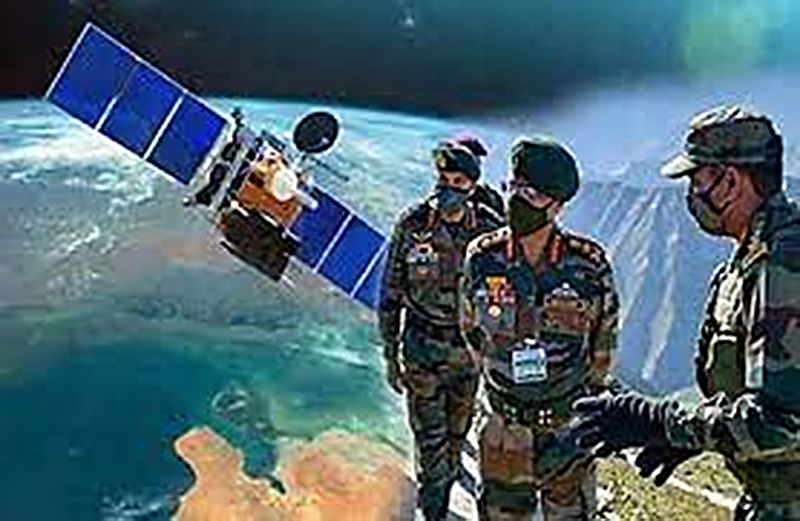India Eyes Satellite Constellation to Bolster its Military Operations
By R. Anil Kumar
- The potential benefits of satellite constellation for the Indian military are vast. It can facilitate real-time communication between ground troops, unmanned aerial vehicles (UAVs), and command centres, enabling better coordination and decision-making during military operations.
- India to launch GSAT 7R, a replacement satellite for the GSAT 7 Rukmini satellite of the Indian Navy, by January 2024 on-board the GSLV MK2 rocket of ISRO.
Bangalore, September 22. Effective communication plays a pivotal role in the success of any military mission, and military satellites offer a secure and reliable form of communication for military forces. The C4ISR concept has also emphasised the importance of satellite-based military communication, with the increasing use of sensors on the battlefield.

India’s Military Communication Satellites have emerged as a vital tool for modern warfare, supporting various functions, including surveillance, reconnaissance, communication, navigation, and weather monitoring.
These satellites are operated by defence departments, intelligence agencies, and other government bodies, as they are dual-use in nature and can be utilised by both civilian and military organisations.
Dedicated military communication satellites provide several advantages over other forms of communication for military forces, including secure communication, global coverage, high bandwidth, and flexibility. These satellites offer secure and encrypted communication links that are protected from interception or eavesdropping by hostile forces, ensuring the confidentiality of military communications and maintaining operational security.
Additionally, military communication satellites provide communication coverage across the entire globe, including remote or hostile environments where other forms of communication may not be possible.
India recognises the importance of a robust military communication infrastructure and currently has three operational dedicated communication satellites for military purposes in service and several dual-purpose satellites. These satellites provide the Indian military with secure and reliable communication links, enabling them to operate effectively and efficiently in various environments and situations.
As countries modernise their military communication infrastructure, military satellites will remain a vital tool for military organisations worldwide. Dedicated military communication satellites will continue to provide critical advantages for military forces, including secure communication, global coverage, high bandwidth, and flexibility. India’s Military Communication Satellites are a prime example of how a country can establish a reliable military communication infrastructure to meet its strategic requirements.
According to sources familiar with the matter, India’s military relies on three dedicated communication satellites for operational and tactical needs.
The satellites GSAT-7 (Rukmini), GSAT-6, and GSAT-7A (Angry Bird) enable real-time communication and provide voice, video, and data communication, navigation, and reconnaissance services to naval ships, submarines, aircraft, and ground stations.
GSAT-7 (INSAT-4F), also known as Rukmini, operates in the UHF, S, and Ku bands and has a coverage area of the Indian Ocean Region (IOR) up to 2,000 km from the Indian coastline. The satellite can simultaneously support the communication needs of more than 50 naval ships and aircraft across the Arabian Sea and the Bay of Bengal. GSAT-7 enables real-time secure communication between naval assets, including ships, submarines, and aircraft, and facilitates interoperability with other military forces.
GSAT-6 operates in the S-band frequency and provides communication capabilities to the Indian armed forces in remote and border areas. The satellite’s national beam also provides communication services for civilian applications, such as telemedicine, disaster management, and education required in the frontline states of India.
GSAT 7A (Angry Bird), the first dedicated communication satellite for the Indian Air Force, operates in the Ku-band frequency range and provides secure and reliable communication links for strategic and tactical operations. The satellite enables real-time situational awareness, which is essential for modern warfare.
India plans to replace and augment its dedicated military communication satellite constellation in the coming years to keep up with evolving threats.
The country will launch GSAT 7R, a replacement satellite for the GSAT 7 Rukmini satellite of the Indian Navy, by January 2024 on-board the GSLV MK2 rocket of ISRO.
The defence ministry also has signed a contract worth ₹3,100 crores (US$43.6 million) with New Space India Limited (NSIL) for GSAT-7B, an advanced communication satellite that will be the first dedicated communication satellite for the Indian Army.
GSAT 7C will be the Indian Air Force’s second operational communication satellite and will work with GSAT 7A to provide services to the Indian Air Force.
With the development of Anti-Satellite (ASAT) weapons, space-based assets have come under a possible threat of being taken down in any conflict.
India is working towards developing a capability to maintain ready-to-launch backup satellites on the ground and launch on-demand rocket capability to replace such a loss in a conflict.
Further communication satellites are usually beyond 30,000 km altitude, reducing any possible threats from ASAT ground-based weapons. Space-based assets are now a necessity, and India will continue to work to develop capabilities to support its defence forces.





